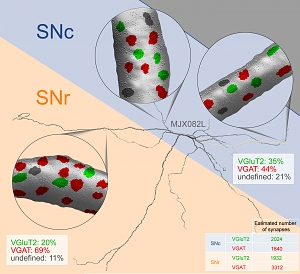Structural correlates of heterogeneous in vivo activity of midbrain dopaminergic neurons
Pablo Henny, Matthew T. C. Brown, Augustus Northrop, Macarena Faunes, Mark A. Ungless, Peter J. Magill and J. Paul Bolam Nature Neuroscience (2012) 15:613-619
Dopaminergic neurons of the substantia nigra pars compacta (SNc) exhibit functional heterogeneity that is likely to underpin their diverse roles in behavior. We examine how the functional diversity of identified dopaminergic neurons in vivo correlates with differences in somato-dendritic architecture and afferent synaptic organization. Stereological analysis of individually recorded and labeled dopaminergic neurons of rat SNc revealed that they receive approximately 8000 synaptic inputs, at least 30% of which are glutamatergic and 40%-70% are GABAergic. The latter type of synapses are proportionally greater in number and denser on dendrites located in the substantia nigra pars reticulata (SNr) than on those located in SNc, thus revealing the existence of two synaptically-distinct and region-specific subcellular domains. We also show that the relative extension of SNc neuron dendrites into the SNr dictated overall GABAergic innervation and predicted inhibition responses to aversive stimuli. We conclude that diverse wiring patterns are key determinants of the heterogeneous activities of midbrain dopaminergic neurons in vivo.
See Commentary by Javier and Krietzer Nature Neuroscience (2012) 15:503–505.
